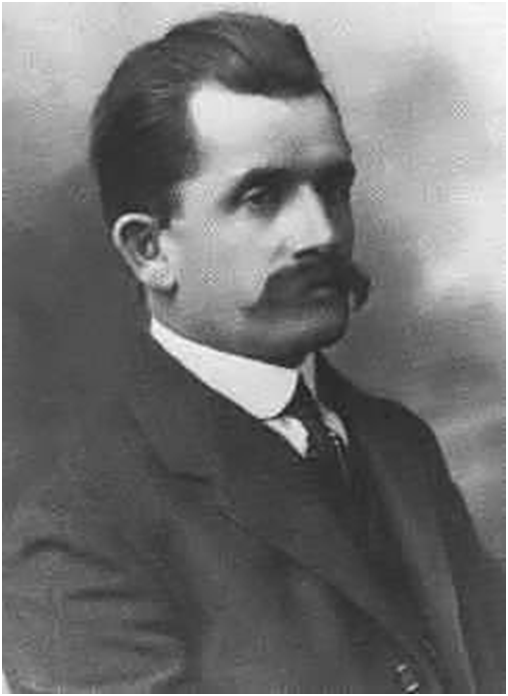The name "Volks-wagen" is German for "People's Car....
The year was 1930 when Ferdinand Porsche created the automotive design company known as the Porsche Büro. Porsche and his newly founded company were pivotal in revolutionary design and engineering developments in the automotive industry. In 1931 Ferdinand began his pet project, the Type 12, which was the predecessor to the car that would become known as the “Käfer”. The Type 12 was a streamlined 2 door sedan designed for a German motorcycle company named Zündapp. However indecision over what engine to place inside of it ended its life prematurely. Zündapp wanted to put one of their 1.2l motorcycle engines inside of the Type 12, but it seems Porsche wasn’t having that and development on the Type 12 ended there.
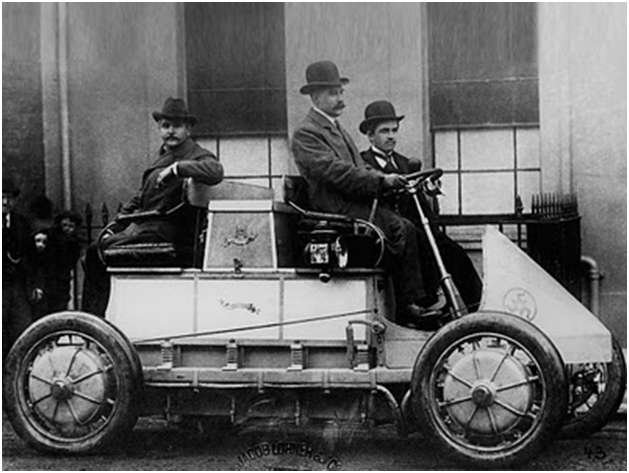
In 1925 Auto designer Bela Barenyi of Benz develops initial raw sketch of the earliest form of a Käfer-like auto. The concept is scrapped and never developed any further. Additionally, further inspiration of the Käfer's design was inspired by the advanced Tatra cars of Hans Ledwinka, particularly the T97. This also had a streamlined body and a rear-mounted 4 cylinder horizontally-opposed air-cooled engine. Tatra launched a lawsuit, but this was stopped when Germany invaded Czechoslovakia. The matter was re-opened after WW2 and in 1961 Volkswagen paid Tatra 3,000,000 Deutsche Marks in compensation. These damages meant that Volkswagen had little money for the development of new models and the Beetle's production life was necessarily extended.
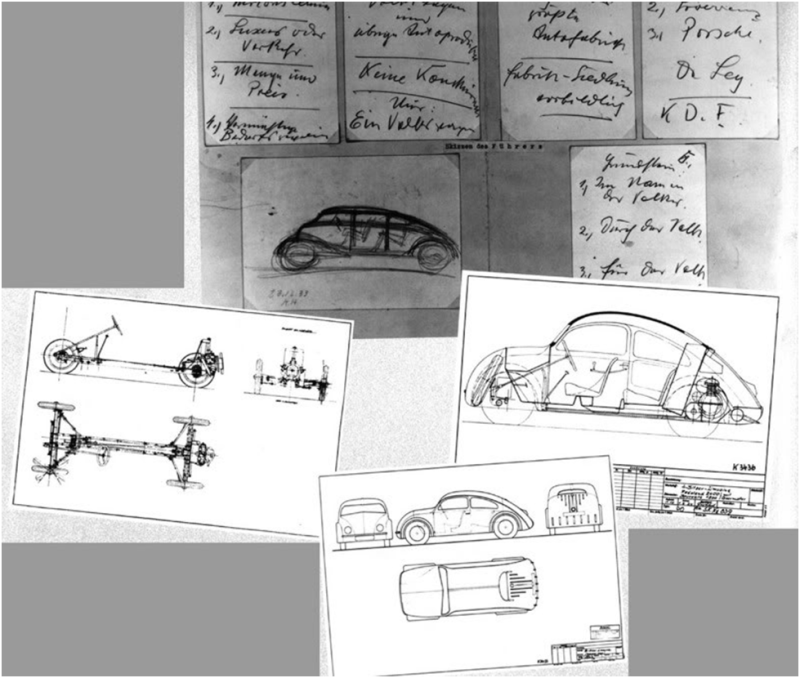
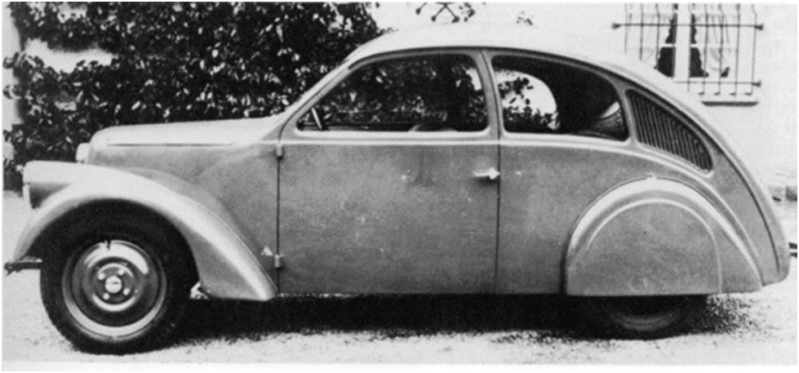
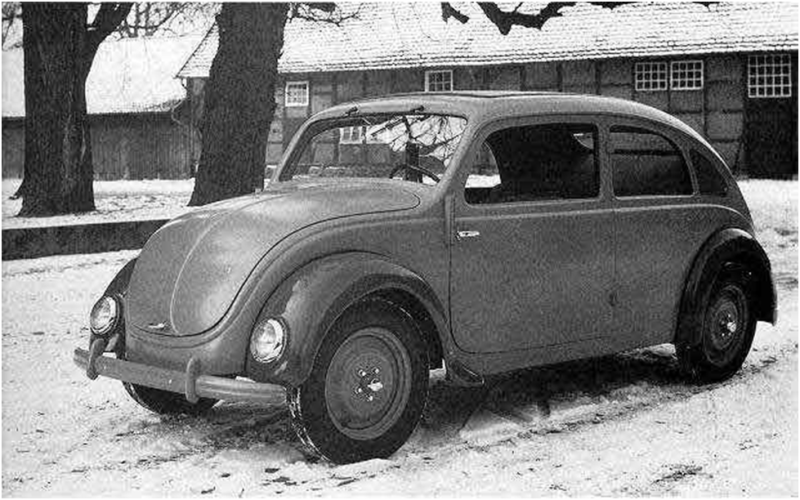
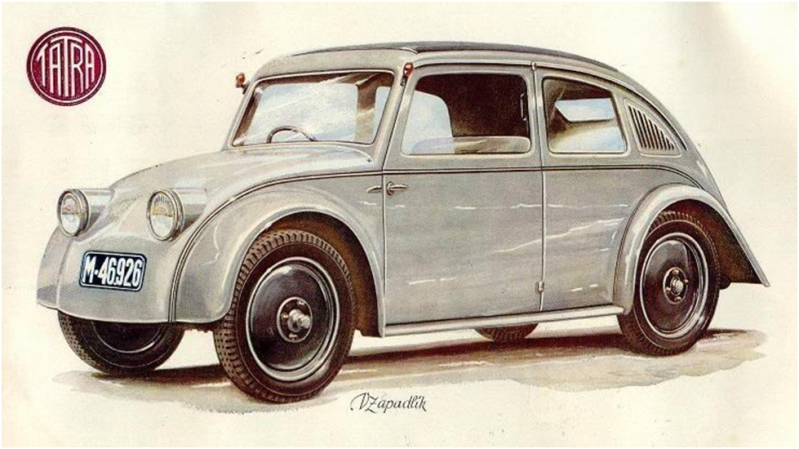
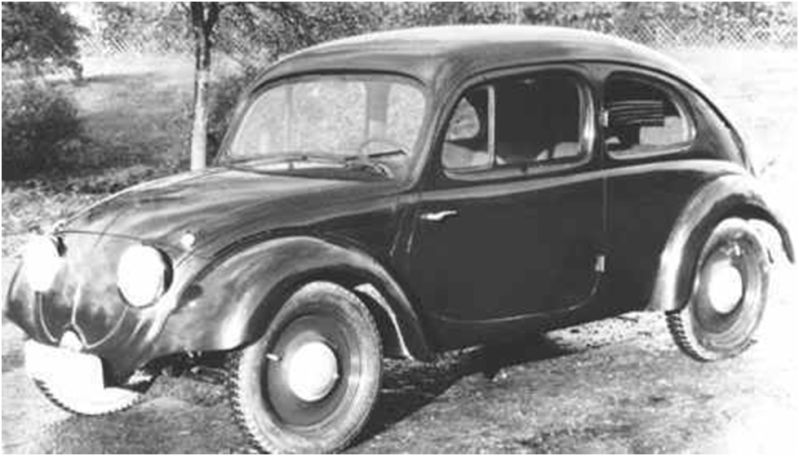
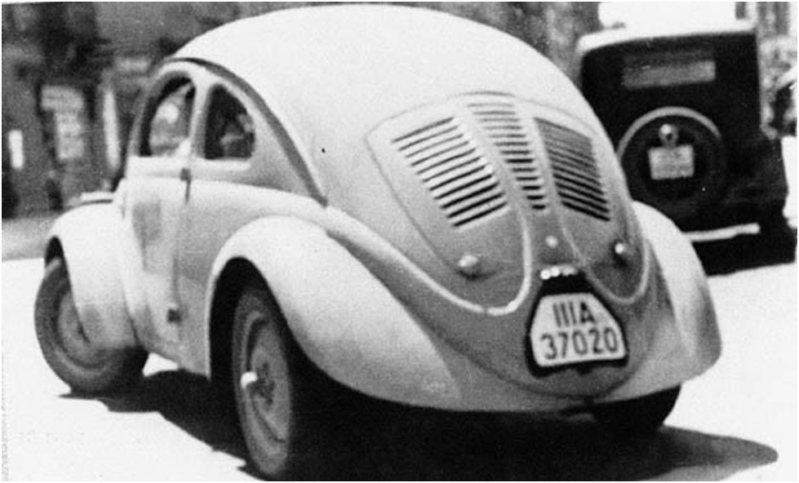
Racing Heritage
In spring 1933 Ferdinand Porsche was given the assignment by Auto Union in Saxony to develop a 16-cylinder racing car based on the regulations in the new 750kg racing formula. Immediately after conclusion of the contract, Porsche's team led by Senior Engineer Karl Rabe started work on the mid-engine Auto Union P racing car (the "P" stands for Porsche). The first test drives were conducted as early as in January 1934, and in its very first racing season also in 1934 the new car not only set up three world records, but also won three international Grand Prix races as well as several hill climb events. With drivers such as Bernd Rosemeyer, Hans Stuck or Tazio Nuvolari at the wheel, the Auto Union racing car consistently enhanced to an ever-increasing standard between 1934 and 1939 became one of the most successful racing cars in the pre-war era. Indeed, its mid-engine concept soon set the trend for all modern racing cars and is still applied today in Formula 1.
In 1939 with the aid of his new invention the "wind-tunnel" Porsche developed the "VW Aerocoupe". Only 3 VW Aerocoupes were made. One was wrecked by a VW executive, and the remaining 2 were used by the Porsche family. Eventually Porsche put one in storage. In May 1945 American troops discovered the one put in storage, cut the roof off and used it for joyriding for a few weeks until the engine gave up and it was scrapped.
The last remaining VW Aerocoupe was owned by Ferry Porsche who had it restored by Pinin Farina in 1947. In 1949 it was sold to the Austrian motorcycle racer Otto Matte and with it he won the Alpine Rally in 1950. The last time he drove it in a race was at the Monterey Historic Races in Monterey, California in 1982.
Porsche began to experiment further with lightening his cars by opting not to paint them to save a few ounces. The autos remained raw silver as they were made from aluminum.
*Side note: Because of this, over the year’s auto manufacturers gradually began to present new cars in "thier"color. The German racing color is silver. British is forest green. Italian is red and French/American is blue.
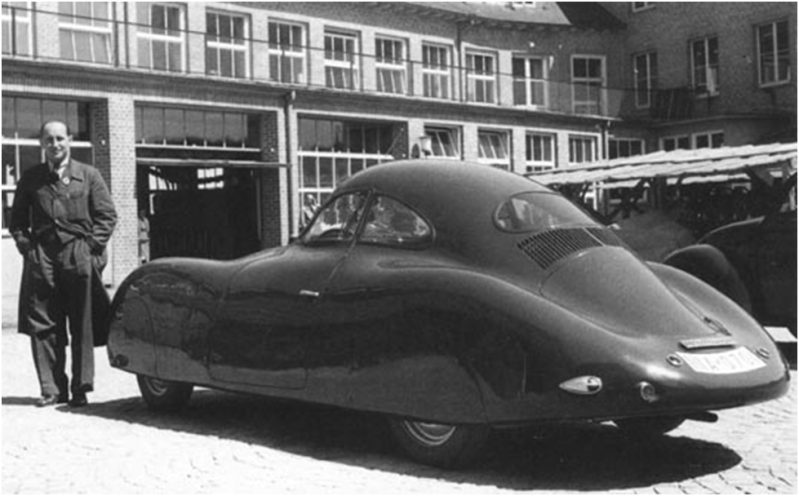
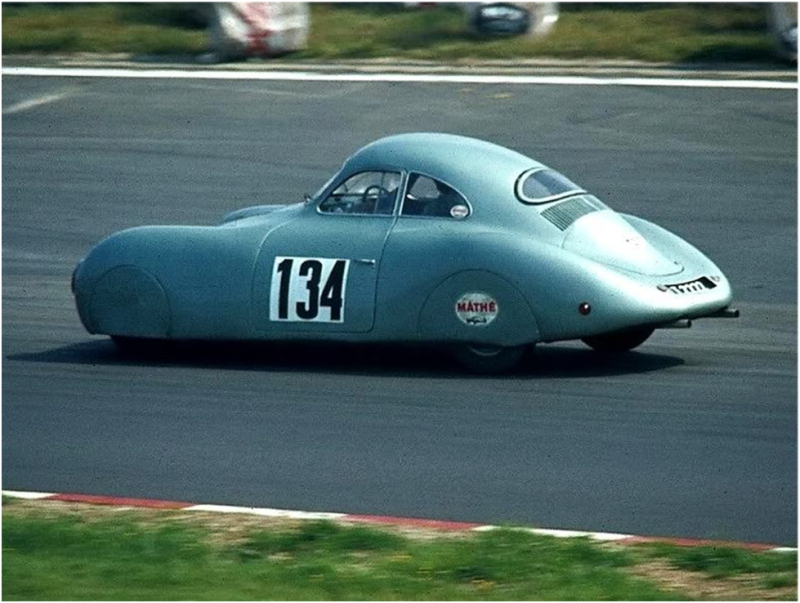

Volkswagen & the "Dark Era"
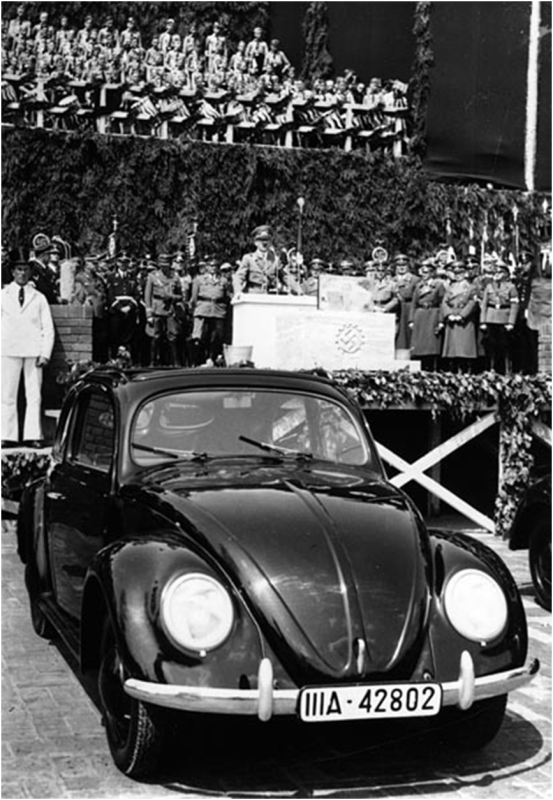
The name "Volks-wagen" is German for "People's Car....
.....Hitler renames it the KdF-Wagen.

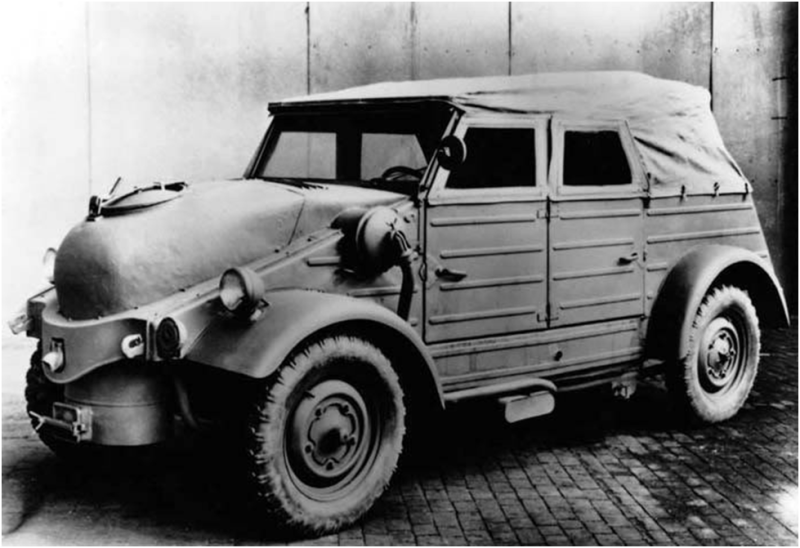
*Side note: Adolf Hitler himself could not drive, but was a car fanatic.
At the time there were 3 major car designers in Germany. Joseph Ganz, Edmund Rumpler and Porsche. As the first two were Jewish, and since Porsche had designed many of the Mercedes-Benz cars Hitler loved, Porsche was selected. Thus began the darker times in Volkswagen’s history.
Hilter approached Dr. Ferdinand Porsche shortly thereafter and demanded that Porsche make changes to his original 1931 design to make it more suited for the working man. Hans Ledwinka of Tatra discussed his ideas with Ferdinand Porsche, who later used many Tatra design features in the 1938 Kdf-Wagen, later known as the Beetle.
Even though the dictator's "friendly" relationship with the Porsches seemed mutual to Hitler himself and others, in reality it was one-sided. The Porsche family was, in fact, somewhat pacifist. The family didn't agree with Nazi ideals, in fact Porsche once assisted a Jewish employee escape Germany.
Nazi officials pressured Porsche to put a Swastika in the VW emblem. Porsche was non-political and just wanted to build cars. He refused and they settled on the KdF Logo featuring the "VW" and cogs, along with a backwards swastika variation to make the Nazi Officials happy.
Prototypes of the car called the "Kdf-Wagen" (German: Kraft durch Freude -- "strength through joy"), appeared from 1936 onwards (the first cars had been produced in Stuttgart). The car already had its distinctive round shape and air-cooled, flat-four, rear-mounted engine. The VW car was just one of many KdF programmes which included things such as tours and outings. The war started in 1939. Consequently, during this same year, Porsche invents the "Wind-tunnel" and uses it to design the ultra sleek "Volkswagen Aerocoupe.
Hitler began to demand Porsche to create military vehicles for use against the allies....enter the VW Dark Era.
Following the fall of the Third Riech, in November 1945 the French government requested formally to the Porsche family to build a French version of the compact Volkswagen.
The French government even planned on disassembling the entire factory and moving it back to France as war reparations but was stopped by the French auto industry because they didn't want competition.
Some French nationalist sectors, lead by Jean Pierre Peugeot, resisted this though. Surprisingly then, during an official appointment at Wolfsburg, Porsche his son Ferry as well as Anton Piëch, a Viennese attorney who was Porsche's son-in-law were arrested altogether as criminals of war, on December 15. Without any trial, a bail of 500,000 francs was officially asked for each of the Porsche's. It could be afforded only for Ferry Porsche who moved then to Austria, on July 1946. His father was taken instead to a harsh medieval prison in Dijon, France.
The Volkswagen Company owes its postwar existence largely to British army officer Major Ivan Hirst (1916–2000). After the war, Hirst was ordered to take control of the heavily bombed factory, which the Americans had captured. His first task was to remove the unexploded bomb which had fallen through the roof and lodged itself between some pieces of irreplaceable production equipment; if the bomb had exploded, the Beetle's fate would have been sealed. Hirst persuaded the British military to order 20,000 of the cars, and by 1946 the factory was producing 1,000 cars a month. The car and its town changed their Nazi-era names to Volkswagen (people's car) and Wolfsburg, respectively. The first 1,785 Beetles were made in a factory near Wolfsburg, Germany in 1945.
The Post-War Years
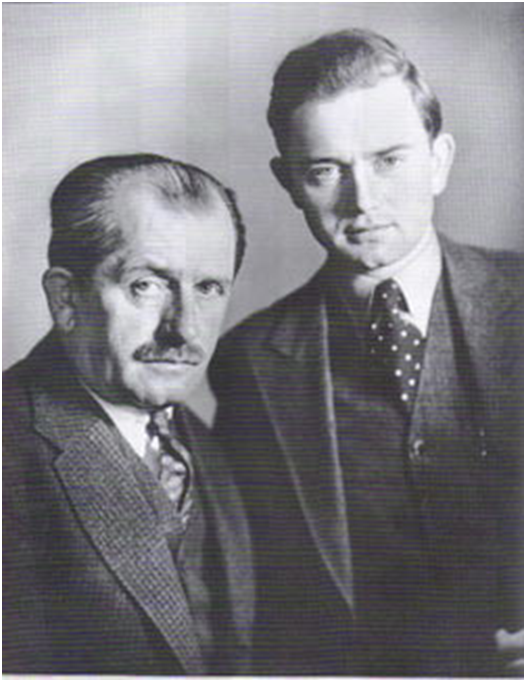
In 1948 while his father was in prison in France, Ferry Porsche maintained the company and its business deals. Aided by the postwar Volkswagen enterprise, he set to further establish Porsche in Gmund, Austria out of converted sawmill because they were not allowed back into Stuttgart by the occupying Allies. Despite the political-economical adversities of the postwar years and the designing labors, the company manufactured automobiles and, eventually, became a world powerhouse for producing sport cars.
Following his father's old aspiration, the first Volkswagen 356 is produced in 1948 but with encouragement from the Porsche board, they rename the car the Porsche 356, citing that people would not want to pay the higher price for a Volkswagen. The reason being is that Volkswagen was known as the "affordable car". The VW-Porsche 356 had a rear engine of 35 hp and 4-cylinders which was air-cooled. Due to the location of its engine, the car was a slightly unstable while being driven but the balance favored the vehicle's light-weight design.
In 1949 and with finances now more secure, Porsche made plans to return to Stuttgart and in September 1949, reopened offices in space rented from the Reutter body works. Steel-bodied 356’s went into production there soon after. Initial plans were to build up to 500 cars a year Eventually more than 78,000 356s would be built in 17 years.
Despite its compact design, the now "Porsche" 356 was eventually reserved for wealthy customers. Successful with the 356 would mean Porsche could finally halt the performing of design chores for others. Indeed surprisingly, the 356 had almost sold 78,000 units by 1965. Additionally, it laid down the foundation which was followed by the entirety of the successive series of Porsche's sport cars.
Porsche was now stood alone on its own as an auto mark, but still very much involved with Volkswagen. It cooperated on several projects with Volkswagen as it has since the beginning and still does to this day.
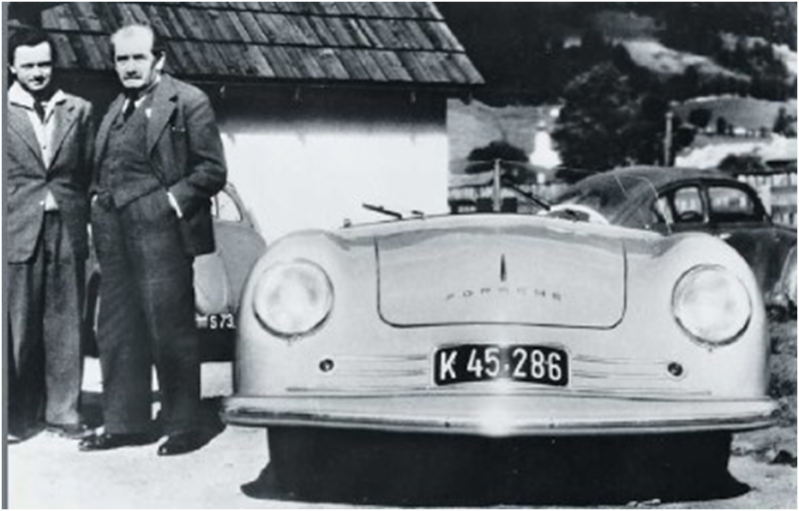
In September of 1950, Porsche celebrated his 75th birthday. A huge party was staged, and the courtyard of the family villa was filled with friends and associates from years past.. .and with Porsches and Volkswagens.
In November, Ferry took his father for one last look at the Wolfsburg Volkswagenwerk, now literally humming full speed with production of the popular VW Beetle. It was the first time the Professor had seen the plant since the end of the War.
Later in November, Porsche suffered a stroke. He never recovered, and he succumbed January 30, 1951. His legacy, that of an untrained and largely uneducated young man who became one of the greatest automobile engineers of all time, lay in the countless design innovations now distilled down to one car which his son had designed and which would live on today....the Porsche sports car.
Ferry was an engineer cut from the self-made mold of his father. As a man and a manager, he was distinctly different. Ferry was mild-mannered and unassuming; he preferred teamwork and consensus. But, like his father he worked hard and he inspired others to bend to the tasks before them.
Founded on his design and built on his skills, the Porsche firm prospered. The little Type 356 became a success: an engineer’s cult car in America the gentry’s quirky toy in Europe. Racing entered the picture almost immediately. Some of the lightweight aluminum coupes built in Gmund were adapted for racing as early as 1951. Prototype Type 550s followed in 1951 and by 1954, with the Fuhrman four-cam Type 547 motors in them, the Spyders were winning the 1500-cc class frequently and winning overall occasionally. They became known as ‘giant killers, the little cars that could.’
Volkswagen-Porsche
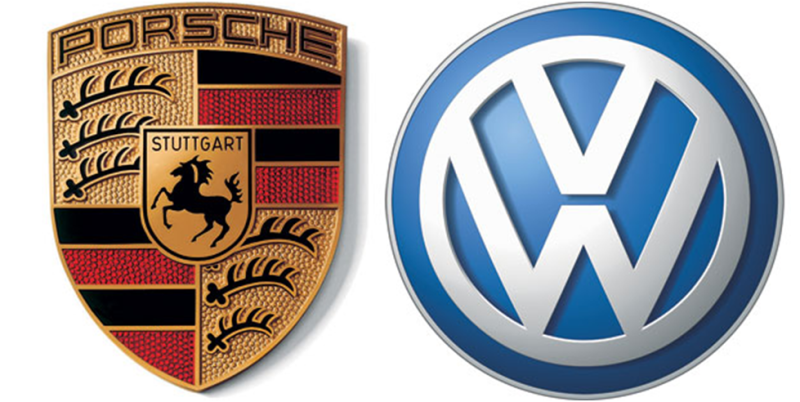
Volkswagen, on its own now..
As previously stated, Volkswagens were first exhibited and sold in the United States in 1949. It only sold two units in America that first year. On its entry to the U.S. market, the VW was briefly sold as a "Victory Wagon".
Volkswagen of America was formed in April 1955 to standardize sales and service in the U.S. Production of the Type 1 Volkswagen Beetle increased dramatically over the years, the total reaching one million in 1955.
Sales eventually soared, due in part to the famous advertising campaigns by New York advertising agency, Doyle, Dane and Bernbach. Volkswagen ads became as popular as the car, using crisp layouts and witty copy to lure the younger, sophisticated consumers with whom the car became associated. Despite the fact it was almost universally known as the Beetle, it was never officially labeled as such, instead referred to as the Type 1. The first reference to the name Beetle occurred in U.S. advertising in 1968, but not until 1998 and the Golf-based New Beetle would the name be adopted by Wolfsburg.
During the 1960s and early 1970s, although the car was becoming outdated, American exports, innovative advertising and a growing reputation for reliability helped production figures to surpass the levels of the previous record holder, the Ford Model T. By 1973, total production was over 16 million.
VW expanded their product line in 1961 with the introduction of several Type 3 models, which were essentially body style variations (Fastback, Notchback, Squareback) based on Type 1 mechanical underpinnings, and again in 1969 with the relatively unpopular Type 4 (also known as the 411 and 412) models, which differed substantially from previous models with the notable introduction of unibody construction, a fully automatic transmission, electronic fuel injection, and a sturdier power plant.
Volkswagen added a "Super Beetle" (the Type 113) to its lineup in 1971. The Type 113 differed from the standard Beetle in its use of a McPherson strut front suspension instead of the usual torsion bars. Also the nose of the car was stretched 2 inches to allow the spare tire to lay down flat, and the combination of these two features significantly increased the usable trunk space. Despite the Super Beetle's popularity with Volkswagen customers, purists preferred the standard Beetle with its less pronounced nose and its original torsion bar suspension. In 1973, Volkswagen introduced the military-themed Thing (Type 181) in America, recalling the wartime Type 81. The military version was produced for the NATO-era German army (Bundeswehr) during the cold war years of 1970 to 1979. The US Thing version only lasted two years, 1973 and 1974, due at least in part to Ralph Nader's automobile safety campaigns.
Porsche, Moving Forward..
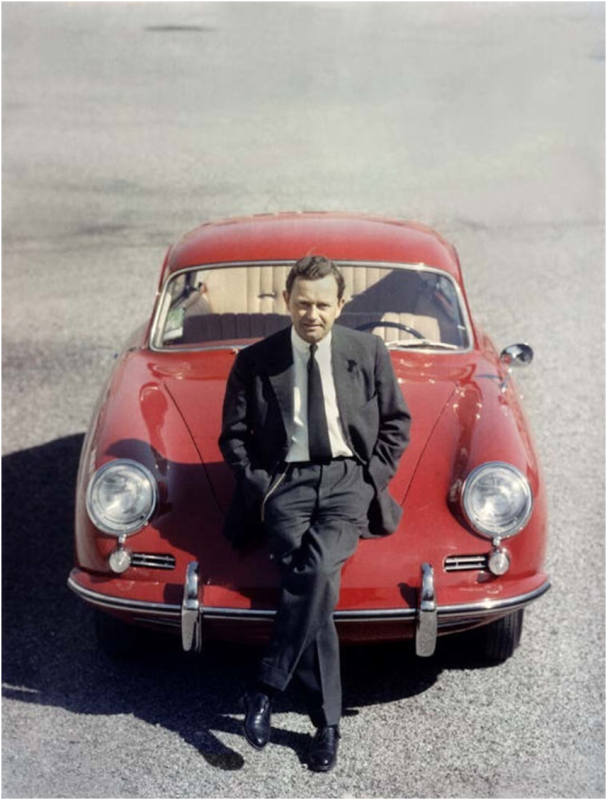
During the late 1950s and early 1960s, few would have predicted that the company could top the 356 -- but it did. The legendary 911 was launched in 1964 and it continues to enjoy the longest production run of any sports car in the world.
Ferry's son, Ferdinand (Ferdy) Alexander, penned the 911's timeless styling. Enhanced during the past four decades -- the 1974 911 Turbo was the world's first turbocharged sports car -- but never drastically changed, the sixth-generation 911 debuted last year. The car has been a hit with customers and critics, which means Porsche will be adding to the 610,000 911s it has sold in the past 40 years.

The Porsche 911 was developed as a much more powerful, larger, more comfortable replacement for the Porsche 356, the company's first model, and essentially a sporting evolution of the Volkswagen Beetle. The new car made its public debut at the 1963 Internationale Automobil-Ausstellung, better known to English speakers as the Frankfurt motor show.
It was designated as the "Porsche 901" (901 being its internal project number). Peugeot protested on the grounds that they owned the trademark to all car names formed by three numbers with a zero in the middle. So, before production started, the new Porsche had its name changed to 911. It went on sale in 1964.
During Ferry's reign, Porsche's commercial success was only helped by its numerous racing triumphs in events such as Le Mans and Formula One.
Ferry stepped down from the company board in 1972 but remained active on the company's advisory board, serving as chairman until 1990. He was the advisory board's honorary chairman until his death on March 27, 1998; in Zell am See, Austria.
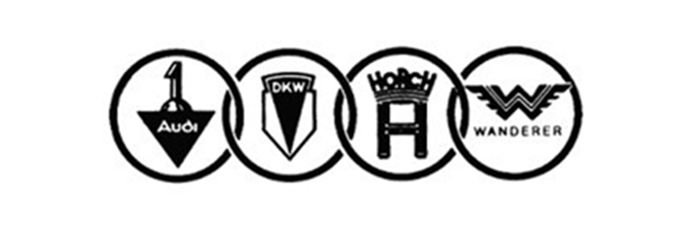
Horch and Audi..."audiatur et altera pars!"
The Audi company traces its origins back to 1899 and August Horch. The first Horch automobile was produced in 1901 in Zwickau. In 1909, Horch was forced out of the company he had founded. He then started a new company in Zwickau and continued using the Horch brand. His former partners sued him for trademark infringement and a German court determined that the Horch brand belonged to his former company. August Horch was forced to refrain from using his own family name in his new car business. Horch immediately called a meeting at the apartment of Franz Fikentscher to come up with a new name for his company. During this meeting Franz's son was quietly studying Latin in a corner of the room. Several times he looked like he was on the verge of saying something but would just swallow his words and continue working, until he finally blurted out, "Father - audiatur et altera pars... wouldn't it be a good idea to call it AUDI instead of HORCH?". "Horch!" in German means "Hark!" which is "Audi" in Latin. The idea was enthusiastically accepted by everyone attending the meeting.
It is also popularly (but incorrectly) believed that Audi is an acronym which stands for "Auto Union Deutschland Ingolstadt".
Audi started with a 2612 cc (2.6 liter) four cylinder model followed by a 3564 cc (3.6 L) model, as well as 4680 cc (4.7 L) and 5720 cc (5.7L) models. These cars were successful even in sporting events. August Horch left the Audi Company in 1920. The first six cylinder model, 4655 cc (4.7 L) appeared in 1924. In 1928, the company was acquired by Jørgen Rasmussen, owner of DKW, who bought the same year the remains of the US automobile manufacturer, Rickenbacker including the manufacturing equipment for eight cylinder engines. These engines were used in Audi Zwickau and Audi Dresden models that were launched in 1929. At the same time, six cylinder and four cylinder (licensed from Peugeot) models were manufactured. Audi cars of that era were luxurious cars equipped with special bodywork.
Prewar Auto Unions are among the most technically and historically significant grand prix race cars ever created. Numerous articles and books have been written about how they disappeared behind the Iron Curtain during the war, of the tenacity of a variety of collectors to find and save them, and the subsequent patience and skill of restorers to bring them back to racing life again.
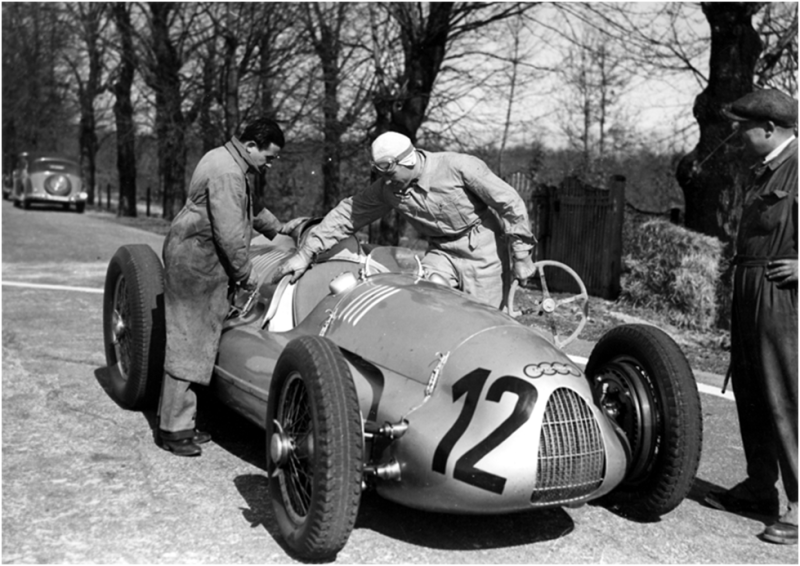
During the 1938 racing season, the V-12s were fitted with single-stage cast-aluminum superchargers, finned for cooling and fed by twin Solex carburetors. This blower was scaled down from the one used on the 6-liter V-16, and displaced 1.4 liters per rev, delivering around 17psi of boost at 2.4 times engine speed.
A Roots-type supercharger loses efficiency at high revs, so Auto Union developed a two-stage design, which was introduced during the 1939 season consisting of a shortened V-16 compressor of 2.25 liters per revolution that fed into a shorter-lobed 1.2-liter-per-rev unit that was based on the standard D-type single-stage blower. Driven at 1.63 times crank speed, this two-stage supercharger provided about 24psi of boost, and around 100 additional horsepower, compared to the single-stage design. The Solex float-chamber carburetors were replaced by float-less pressure carbs jointly developed by Auto Union and the SUM carburetor company in Berlin. In addition, two fuel pumps were fitted, one for fuel feed and the other to return unused fuel to the tank. Cars equipped with the two-stage blower can be recognized by the supplemental air intake for the carburetor and by a bulge on the right rear of the bodywork.
The racing successes of the 1934-1939 V-16 and V-12 Auto Unions are the stuff of legends during a period of great political unrest throughout Europe. Ironically it was the great Italian driver, Tazio Nuvolari, who won the very last race in which Auto Union competed, the Belgrade Grand Prix. The date: September 3, 1939. The race started as the precise moment France declared a state of war against Germany.
Pause and a new start
Auto Union plants were heavily bombed and partly destroyed during World War II. After the war, Zwickau soon became part of the German Democratic Republic and Auto Union headquarters were relocated too. Daimler-Benz acquired 88 per cent of Auto Union and in the next year, 1964, Benz sold the company to Volkswagen. In September 1965 the model was launched, also "relaunching" the Audi brand. The model was classified internally as the F103 and sold as simply the "Audi" (the name being a model designation rather than the manufacturer, which was still officially Auto Union), but later came to be known as the Audi 72. Developments of the model were named for their horsepower ratings and sold as the Audi 60, 75, 80, and Super 90. These models sold until 1972.
In 1969, Auto Union merged with NSU, based in Neckarsulm near Stuttgart. In the 1950s NSU had been the world's largest manufacturer of motorcycles but had moved on to produce small cars like the NSU Prinz (the TT and TTS versions are still popular as vintage race cars). NSU then focused on new rotary engines according to the ideas of Felix Wankel. In 1967, the new NSU Ro 80 was a space-age car well ahead of its time in technical details such as aerodynamics, light weight, and safety, but teething problems with the rotary engines put an end to the independence of NSU. Today the Neckarsulm plant is used to produce the larger Audi models.
The mid-sized car that NSU had been working on, the K70, was intended to slot between the rear-engined Prinz models and the futuristic Ro 80. However, Volkswagen took the K70 for its own range, spelling the end of NSU as a separate brand
The modern era of Audi
The new merged company was known as "Audi NSU Auto Union AG", and saw the emergence of Audi as a separate brand for the first time since the pre-war era. Volkswagen introduced the Audi brand to the United States for the 1970 model year.
The first new car of this regime was the Audi 100 of 1968. This was soon joined by the Audi 80/Fox (which formed the basis for the 1973 Volkswagen Passat) in 1972 and the Audi 50 (later, rebadged as the Volkswagen Polo) in 1974.
Audi Quattro
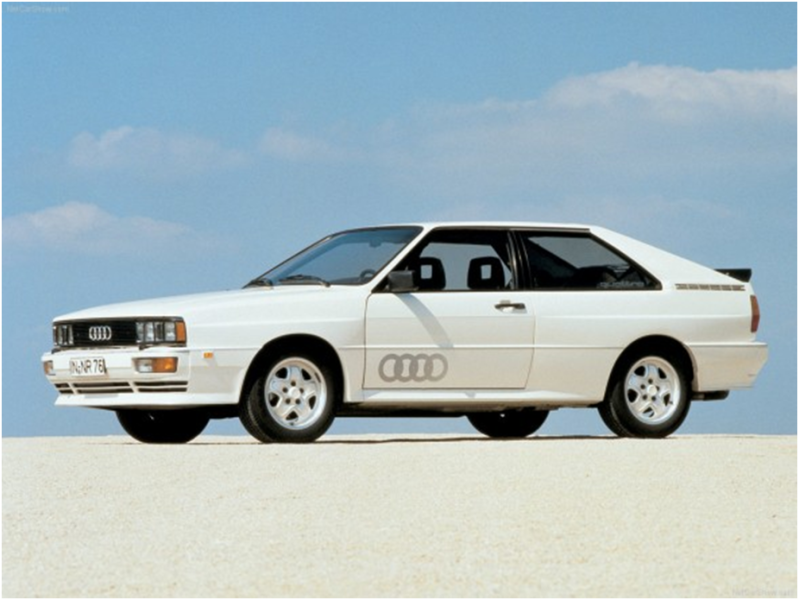
The Audi image at this time was a conservative one, and so, a proposal from chassis engineer Jörg Bensinger[2] was accepted to develop the four-wheel drive technology in Volkswagen's Iltis military vehicle for an Audi performance car and rally racing car. The performance car, introduced in 1980, was named the "quattro," a turbocharged coupé which was also the first German large-scale production vehicle to feature permanent all-wheel drive through a center differential (not counting the earlier British Jensen FF, produced in small numbers). Commonly referred to as the "Ur-Quattro" (the "Ur-" prefix is a German augmentative used, in this case, to mean "original" and is also applied to the first generation of Audi's S4 and S6 sport sedans, as in "UrS4" and "UrS6"), few of these vehicles were produced (all hand-built by a single team) but the model was a great success in rallying. Prominent wins proved the viability of all-wheel drive racecars, and the Audi name became associated with advances in automotive technology.
In 1985, with the Auto Union and NSU brands effectively dead, the company's official name was now shortened to simply "Audi AG".
In 1986, as the Passat-based Audi 80 was beginning to develop a kind of "grandfather's car" image, the type 89 was introduced. This completely new development sold extremely well. However, its modern and dynamic exterior belied the low performance of its base engine, and its base package was quite Spartan (even the passenger-side mirror was an option.) In 1987, Audi put forward a new and very elegant Audi 90, which had a much superior set of standard features. In the early nineties, sales began to slump for the Audi 80 series, and some basic construction problems started to surface.
This decline in sales was not helped in the USA by a 60 Minutes report which purported to show that Audi automobiles suffered from "unintended acceleration". The 60 Minutes report was based on customer reports of acceleration when the brake pedal was pushed. Independent investigators concluded that this was most likely due to a close placement of the accelerator and brake pedals (unlike American cars), and the inability, when not paying attention, to distinguish between the two. (In race cars, when manually downshifting under heavy braking, the accelerator has to be used in order to match revs properly, so both pedals have to be close to each other to be operated by the right foot at once, toes on the brake, heel on the accelerator.). This did not become an issue in Europe, possibly due to more widespread experience among European drivers with manual transmissions.
60 Minutes ignored this fact and rigged a car to perform in an uncontrolled manner. The report immediately crushed Audi sales, and Audi renamed the affected model (The 5000 became the 100/200 in 1989, as it was elsewhere). Audi had contemplated withdrawing from the American market until sales began to recover in the mid-1990s. The turning point for Audi was the sale of the new A4 in 1996, and with the release of the A4/6/8 series, which was developed together with VW and other sister brands (so called "platforms").
Currently, Audi's sales are growing strongly in Europe. 2004 marked the 11th straight increase in sales, selling 779,441 vehicles worldwide. Record figures were recorded from 21 out of about 50 major sales markets. The largest sales increases came from Eastern Europe (+19.3%), Africa (+17.2%) and the Middle East (+58.5%)[citation needed]. In March of 2005, Audi is building its first two dealerships in India following its high increase in sales in the region.
Audi has recently started offering a computerized control system for its cars called Multi Media Interface (MMI). This comes amid criticism of BMW's iDrive control, essentially a rotating control knob designed to control radio, satellite navigation, TV, heating and car controls with a screen. MMI has been widely reported to be an improvement on BMW's iDrive. (BMW has since made their iDrive more user friendly.)
MMI has been generally well-received, as it requires less menu-surfing with its mass of buttons around a central knob, with shortcuts to the radio or phone functions. The screen, either color or monochrome, is mounted on the upright dashboard, and on the A6 and A8, the controls are mounted horizontally. However, an "MMI Like" system is also available on the Audi A3 and A4 models when equipped with the optional Navigation System.
AUTO UNION V-12 – John Dinkel …on making the magic
To replace the 750 kilogram formula for Grand Prix cars that expired at the end of 1937 the Sporting Commission decreed, “from January 1, 1938 to December 31, 1940 that maximum engine capacities should be limited to 3 liters if it be supercharged and 4.5 liters if that adjunct to higher speed was not employed.”
With that edict the V-16 C-type Auto Unions, which had run the 1934-1937 Grand Prix Formula became obsolete. Professor Ferdinand Porsche had been responsible for both design and development of the C-type’s 16 cylinder engine. This basic 45=degree V-16 “grew” in displacement every year, starting at 4358cc and ending in 1937 at 6329cc. Over that four-year period, the output of this supercharged engine nearly doubled: from 285 to 545. It shouldn’t be surprising that the C-type, with its forward-mounted driving position and mid-engined configuration, was prone to extreme over steer.
For 1938-1939 Professor Robert Eberan von Eberhorst took responsibility for the development of the D-type Auto Union from Dr. Porsche. Eberhorst chose to design a 60-degree V-12, supercharged and with a compression ratio of 10.0:1. With a 65mm bore and stroke of 75mm, the engine displaced 2985cc, producing 420bhp at 7000rmp the first year and 485bhp at 7000rpm the next. Maximum torque for the more powerful version was 405lb-ft at 4000rpm.
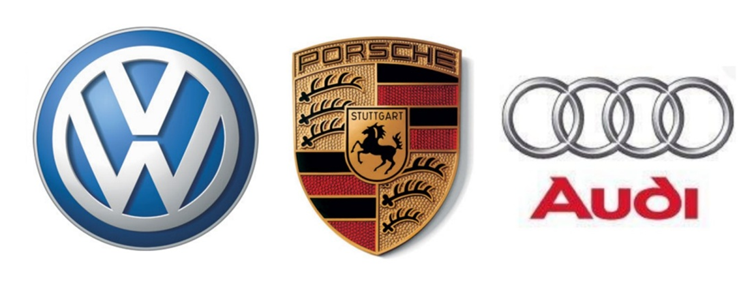
• 1875 - Ferdinand Porsche born in Reichenberg (Northern Bohemia)
• 1893 -The young Porsche demonstrated excellent mechanical aptitude and at age 18, was recommended for a job in Vienna with Bela Egger (later Brown Boveri). In Vienna, he sneaked into night classes at the Technical University, the only ‘formal’ engineering education he ever obtained.
• 1900 -Ferdinand Porsche gets first job and invents the first electric car while working for a automobile company called "Jacob Lohner & Co." in Vienna, Austria. The automobile is displayed at the World's Fair in Paris.
• 1905 - Porsche won the "Poetting Prize" as Austria’s outstanding automotive designer. His outstanding reputation spreads across Europe.
• 1906 - Austro-Daimler lures Porsche to be their chief designer.
• 1909 - Porsche's son is born, "Ferdinand Anton Ernst Porsche" nicknamed "Ferry" (Fuhr-ee). Porsche receives the news of his son's birth via telegram following a race at the Semmering Pass in Austria.
• 1917 - Porsche receives what became his most cherished honor, an honorary doctorate from Vienna Technical University, the same institution where 24 years earlier he had snuck into night classes. This degree was designated by the now-famous ‘Dr. Ing. h.c.’ which was forever to be part of the professor’s persona and eventually part of his firm’s name, "Dr. Ing. h.c. F. Porsche AG".
• 1920 - Porsche begins to embrace auto racing as a way to improve his cars.
• 1920 - Porsche family moves to Stuttgart to be closer to Austro-Daimler.
• 1922 - Ferry Porsche begins car racing at the age of 14 with a car designed by his father and wins his class in Targa, Floria Sicicly.
• 1925 - Auto designer Bela Barenyi of Benz develops initial raw sketch of the earliest form of a Beetle-like auto. The concept is scrapped and never developed any further.
• 1926 - Austro-Daimler merges with Benz, becoming Mercedes Benz. The new merger shifts the interest of the company to luxury autos.
• 1928 -Son Ferry Porsche, age 18, takes an internship with Bosch.
• 1929 -Porsche leaves Mercedes-Benz, after the board rejects his concept of light-weight. streamlined cars.
• 1931 -Dr Ferdinand Porsche starts "Porsche Büro" aka "Dr. Ing. h.c. F. Porsche GmbH Konstructionsbüro für Motoren, Fahrzeuge, Luftfahrzeuge und Wasserfahrzeugbau" in Stuttgart, more commonly known as "Dr. Ing. h.c. F. Porsche AG". The firm designed construction and consultation for engines, automobiles, airplanes and motorboats. The Volkswagen factory remains in Wolfsburg
• 1931 -During his firms first year, Porsche sketches the "Beetle", inspired by Barenyi's rough sketch from 1925.
• 1933 -Ferdinand Porsche was given the assignment by "Auto Union" in Saxony to develop a 16-cylinder racing car.
• 1934 -Porsche invents the "Torsion Bar".
• 1934 -June 22nd, Adolf Hitler "contracts" Porsche to develop the Beetle or as Hilter called it, the "KdFWagen".
• 1936 -Berlin Auto Show. Hitler announces the production of the Beetle.
• 1939 -Porsche creates the "Volkswagen Aerocoupe" using his new invention, the "wind-tunnel".
• 1940 -Official unveiling of the "KdFWagen" at Berlin Auto Show. Germany goes to War.
• 1942 -Adolf Hitler forces Volkswagen to further the Nazi movement with military vehicle production.
• 1942 - Porsche invents "Quattro" for use in the military vehicles.
• 1945 - War ends. Following the capture of Wolfsburg and the VW Factory by American troops, British forces are given control of Wolfsburg area and VW Factory.
• 1945 -Porsche and Ferry are called to be interrogated for their connections to Nazis. Although acquitted, Porsche Sr. was imprisoned in Dijon, France 2 years.
• 1947 - Porsche is released from prison and returns to Germany in '49.
• 1948 -Heinz Nordhoff was appointed chief executive to operate the Wolfsburg Factory. 20,000 Beetles were produced. Henry Ford considered buying VW for $5 million but then retracted his offer after saying no one would buy the funny little car...(The Beetle would easily go on to out sell the Ford Model T.)
• 1948 - The first Volkswagen 356 is produced in Gmund, Austria.
• 1948 -With encouragement from the Porsche board, they rename the car the Porsche 356, citing that people would not want to pay the higher price for a Volkswagen. The reason being is that Volkswagen was known as the "affordable car". Volkswagen and Porsche are officially two entities.
• 1949 -Porsche becomes Austrian distributor for Volkswagen.
• 1949 -Porsche is now allowed back into Stuttgart and Porsche AG is reestablished back at home.
• 1949 -January 17th: The first Beetle was officially purchased in America by Ben Pon. Max Hoffman became the first Volkswagen importer state side.
• 1951 -Porsche produces the 550 Spyder.
• 1951 -January 10th, Dr. Porsche dies.
• 1952 -Canada sees its first official Beetle.
• 1953 -Volkswagen plant opens in Sao Paolo, Brazil. 500,000th Beetle produced.
• 1955 -September 15th, James Dean is killed in his Porsche 550 Spyder after he flipped it to avoid a car that had turned in front of Dean's car. Dean died instantly with a broken neck.
• 1958 -Volkswagen of America becomes a direct subsidiary of Wolfsburg.
• 1963 - Ferry's son, Ferdy creates "901" renamed later to "911"
• 1964 - 911 is produced.
• 1964 - 912 is follows suit and is produced and offered as "entry 911".
• 1964 -Volkswagen purchases "Audi AG".
• 1965 -10 millionth Beetle produced.
• 1971 - Super Beetle produced.
• 1972 - Porsche's grandson, Ferdinand Piech takes helm of VW/Audi
• 1974 - Water-cooled Rabbit/Golf is officially introduced and likewise the invention of the "Hatch-back" or "Hot-hatch" or "Pocket Rocket" and gave hope to the car enthusiasts who were still hurting from the gas crunch that took away their Detroit Muscle.
• 1977 - Official end of Beetle production in Europe and Americas.
• 1979 - Rabbit GTI debuted in Canada.
• 1980 - Audi releases the "Quattro" and causes a stir in the auto world!
• 1983 - Rabbit GTI debuted in USA.
• 1981 -20 millionth Beetle was produced in Puebla, Mexico.
• 1998 -Volkswagen officially recognizes "Beetle" as a model name.
• 1998 -Ferry Porsche Dies
• 2007 -Porsche AG purchases Volkswagen for $13.7 billion. Along with the purchase comes Audi, Lamborghini, Bentley, Seat, Skoda, etc.
__ More recent updates to be added soon
--------- Courtesy and written by Kristof Zimmer
